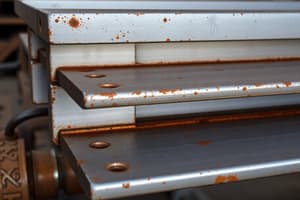Podcast
Questions and Answers
What is the primary role of a structural engineer when it comes to materials?
What is the primary role of a structural engineer when it comes to materials?
- Determining the mechanical properties of materials
- Analyzing the microstructure of materials
- Determining stresses and stress distributions within members (correct)
- Producing and fabricating materials
What is the term for the force applied per unit area?
What is the term for the force applied per unit area?
- Stress (correct)
- Tension
- Deformation
- Strain
What is the relationship between microstructure and mechanical properties?
What is the relationship between microstructure and mechanical properties?
- The mechanical properties determine the microstructure of a material
- The microstructure determines the chemical properties of a material
- There is no relationship between microstructure and mechanical properties
- The microstructure affects the mechanical properties of a material (correct)
What type of analysis is used to determine stresses and stress distributions?
What type of analysis is used to determine stresses and stress distributions?
What is the term for the deformation resulting from stress?
What is the term for the deformation resulting from stress?
Mechanical Properties refers to the ______ of materials when subjected to load/force.
Mechanical Properties refers to the ______ of materials when subjected to load/force.
Examples of Mechanical Properties include ______, Strength, Hardness, Ductility, and Toughness.
Examples of Mechanical Properties include ______, Strength, Hardness, Ductility, and Toughness.
Structural Engineers use ______ and/or theoretical and mathematical stress analyses to determine stresses and stress distributions.
Structural Engineers use ______ and/or theoretical and mathematical stress analyses to determine stresses and stress distributions.
Materials and Metallurgical Engineers produce and fabricate materials to meet ______ requirements.
Materials and Metallurgical Engineers produce and fabricate materials to meet ______ requirements.
Strain is a type of ______ resulting from stress, such as elongation, contraction, or shear.
Strain is a type of ______ resulting from stress, such as elongation, contraction, or shear.




